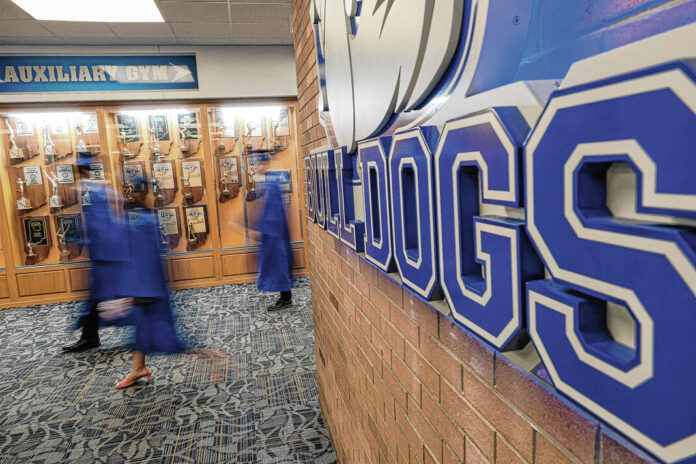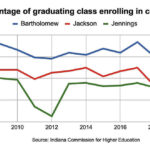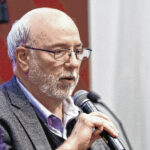
Mike Wolanin | The Republic Members of Columbus North’s Class of 2022 take part in the processional for their commencement ceremony at Columbus North High School in Columbus, Ind., Saturday, May 28, 2022.
The percentage of Bartholomew County high school students who head to college or pursue some form of post-secondary education upon graduation has fallen to a 13-year low, new state figures show.
Just 55.4% of Bartholomew County’s 2020 high school class — the first to graduate during the pandemic — enrolled in college or a post-secondary education program within a year of graduating, according to newly released figures from the Indiana Commission for Higher Education.
That is the lowest percentage on record going back to 2008 and the third consecutive year of declines in the percentage of graduating high school students in Bartholomew County who enroll in post-secondary education, the data shows.
Nearly 72% of Bartholomew County’s 2017 high school class enrolled in a post-secondary program within a year of graduating. But that figure dropped to 65% for the 2018 class and 57.3% for the 2019 class — the two graduating classes immediately before the coronavirus pandemic.
Nationwide decline
Officials say local decline mirrors trends seen statewide and across the country, which they largely attribute to the costs of higher education and — in 2020 — the pandemic.
The Strada Education Network released new national-level figures Wednesday that suggest that more than 1 million fewer students enrolled in college this spring compared to spring 2020 — the fifth consecutive semester of declining enrollment.
Community colleges were hardest hit, accounting for nearly two-thirds of the overall enrollment decline. In addition, applications for federal financial aid are down nearly 9% from last year.
In Indiana, 53.4% of the 2020 high school class enrolled in some sort of post-secondary education program within a year of graduating — the sixth consecutive year of declines and down from 64.8% among the 2015 class, according to state figures.
“It is a national trend that has been going on for many years,” said John Burnett, president and CEO at the Community Education Coalition, a Columbus-based partnership of education, business, and community leaders focused on aligning and integrating the area’s learning system with economic growth and an improved quality of life. “…In terms of matriculation from high school to post-secondary education, things are in decline all across the country.”
Why the decline?
Local officials said many factors could be driving the decrease.
Most notably, in 2020, the coronavirus pandemic disrupted high schools and colleges across the country. The high school class of 2020 finished their last semester of high school remotely, and many colleges didn’t start back up in the fall or operated entirely online or in a limited capacity, potentially leading more students to take a gap year.
In addition, the cost of higher education, the prospect of student loan debt, as well as an academic shift away from pushing every student to go to college in recent years also may be playing a role in the lower percentages of local students enrolling in college, said Bartholomew Consolidated School Corp. Superintendent Jim Roberts.
“It is still very important to get some form of college education, we believe — an associate’s degree, bachelor’s degree, whatever that might be,” Roberts said. “However, we also want students taking advantage of opportunities to get training while they are in high school that might prepare them for a job immediately after high school. What’s interesting with that is that the better job we do preparing a student for something to do immediately after high school, that might drive down the percentage of students who go to college within one year because they’ve chosen to go ahead and take advantage of that opportunity.”
One example, Roberts said, is a welding certificate that students can get while in high school that is leading them to jobs upon graduation that pay “a decent amount of money.” The vast majority of Bartholomew County high school students take at least one technical education course.
“There was a time, it seemed like, where it was, ‘Let’s push kids into college and let that be the thing,’” Roberts said. “And for many kids, that just wasn’t the thing, and people spent a lot of money doing that and then did not complete school and left school with with with no degree, spent a lot of dollars and had student loan debt. And so as we work on having less student loan debt and other things, what are tare the different steps that our kids can take to obtain the things that are necessary to be successful?”
What can be done?
However, local officials say they are optimistic despite the downward trend, pointing to resources in place in the community including the Columbus Airpark Campus.
Burnett, for his part, said many local resources “bode well for Columbus,” highlighting a new set of services that is expected to be available soon at the Columbus Learning Center.
The new set of services will be offered at a new space at the Columbus Learning Center call “The Bridge,” which, according to to a release from the Economic Opportunities through Education (EcO) Network of Southeast Indiana, will be a connection hub for services shared by Ivy Tech, IUPUC and Purdue Polytechnic.
The Bridge will include a welcoming space where “navigators” greet and help visitors, a free snack bar, career services offices for all three schools, six collaborative meeting rooms, a small conference room that can be reserved “by anyone on campus or beyond,” a nursing mother’s room, Council for Youth Development staff offices and CEC staff offices.
“Imagine a year from now, a student will know … here’s a place that I can go to get help, help me think about how I’m going to help myself, connect to work while I’m going to school,” Burnett said.
Overall, Burnett said an important factor for encouraging enrollment in post-secondary education is “continuing to get better and better at helping students and their families understand the really vital connection between learning and economic opportunity.”
Roberts, for his part, said he doesn’t “feel concern at the moment” about the local decrease.
“We want to continue to increase the post-secondary attainment of people,” Roberts said, so there will be opportunities as adults to get more training, to get an associate’s degree, to get something else on top of that to give them more opportunity, that potential to make more dollars as they move on.”
“I think we’re just starting to see a different situation with kids and families and choices, and I don’t consider any of that bad necessarily,” Roberts said.
Andy East | The Republic
Carla Clark | For The Republic John Burnett, president and CEO of the Community Education Coalition, speaks during the panel discussion entitled “Strengthening the Community Through an Educated Workforce” held at the Columbus Learning Center Lecture Hall, Thursday, May 2, 2019.
Photo provided IUPUC Chancellor’s Scholar Nettie Elizabeth Miller, gives an address to the class.
Jim Roberts
Carla Clark | For The Republic Addison Allman joins others in throwing their mortar boards into the air during the Columbus East High School commencement ceremony at Stafford Football Field, Saturday, May 28, 2022.









